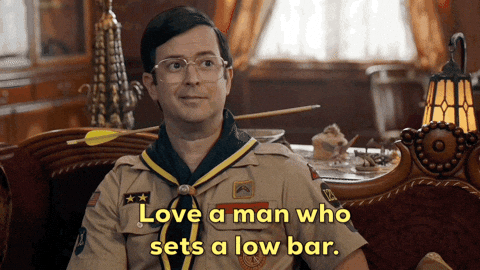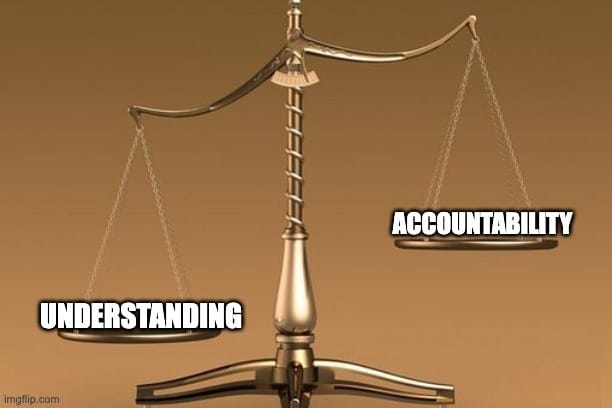- The Deep Dive
- Posts
- "Standards" - A Balancing Act
"Standards" - A Balancing Act
We try to figure out if we know what having standards means!
“Standards” - A Balancing Act
Sam: I’m keen to get your thoughts on “standards” and what that means in a High Performance setting?
I hear coaches talk about their “standards” quite a lot and I’m not 100% sure I know what it means!
Dave: Is it in reference to behavioural standards? Or more skill standards, like standards of execution?
Sam: I’m guessing it means behaviour within the environment. But that’s what I don’t really know and why I want to discuss it. From my experience, coaches in their first season who are wanting to stamp their mark on a program talk a lot about setting standards. They discuss the “high standards” they want to drive in the environment. When you ask the logical follow-up question - what do you mean by “standards” or “high standards,” it gets a little interesting as it can be hard to get clarity on what they mean. Then when you dig deeper again - how it will be driven in practicality, or how people will be held to account, it all becomes a bit Swiss cheese-y - has a few holes in it.

The opposite of this then?
Dave: Swiss cheesy haha, I like that. Yea I think this whole area, if I can label it under the very broad heading of culture, has the tendency to be quite abstract without any specific detail of what it looks like in action, every day. It's something that you hear about from other coaches or environments, but the nuance and application isn't discussed in the same breath as the higher level standards or catchphrase that go along with it.
I literally read this quote this morning and it feels like it fits here:
Borrowed wisdom breaks under pressure because you haven't earned it. You're trusting someone else's compression without knowing what created it. Earned wisdom, on the other hand, holds up because it's rooted in your actual experience. You know when it works, why it works, when to ignore it and when to bend it because you created the compression.
I don’t particularly like the use of the word compression, so substitute that for experience, and I think the quote really works. I think standards are important, critical in fact. But they are the entry point, not the end point.
Sam: I feel they are important too, but there are two things I really struggle with when we talk about "standards."
Standards, in and of itself, is somewhat of a vague concept. It can be hard to get a clear definition, which lends itself of a lack of clarity when you try to scratch the surface of what a coach means by standards or "high standards"
Too often it becomes a rigid set of policies (for lack of a better term) that are based on a fundamental idea that everyone should be treated equally. This may be controversial, but treating people equally isn't fair. Everyone is different, with different needs and challenges. Therefore the way we work with players (even in a team environment) should reflect that. If our goal is to get the best out of everyone and have everyone performing at their highest level for the team, then the fundamental idea sitting under it should probably be - we treat players individually, not equally.
John Wooden ideas on fairness have resonated with me. At the start of his career he thought he should be treating players equally, but started to realise that treating them equally was unfair.
One of Wooden's early season team addresses is covered in the book You Haven't Taught Until They Have Learned. He tells the players -
"I am not going to treat you players all the same. Giving you the same treatment does not make sense because you're all different.... You are different from each other in height, weight, background, intelligence, talent, and many other ways. For that reason, each one of you deserves individual treatment that is best for you."

Wooden might have treated all these players differently, but it ended in the same result… another NCAA title!
These are the sort of real life examples that we see that challenge the standard status quo and bring into question whether we need to have more nuance when talking about standards -
You have a "standard of being on time" - A player lives an hour away from the training venue and has to catch multiple forms of public transport just to get to training. Are they given more leniency when they're late due to issues with public transport?
You have a standard of "you must train the week of a game to be available for selection" - An athlete is playing at a high level at another sport. They need to miss training to rest/manage their load during the week, or have a game that clashes with training. Are they available to be selected even if they can't make training?
You have a "standard of respecting teammates" - A player who has been exemplary all year and the week of finals is having some challenges at home, then during a training session gets into a heated verbal and physical altercation with a teammate. Do you need to punish them/remove them from selection for the behaviour?
To be clear, this is not saying that there should be no accountability for people and their behaviour, especially if it doesn't align to the team's interests and support them being their best. it is just often that the rigidity of the standards and the idea of everyone needing to be treated equally forces you to be bound by them. It allows no flexibility to take into account that we are dealing with real people and all the messiness that comes with it!
If we start from the fundamental idea that in our environments people should be treated individually, not equally, the questions I grapple with are:
What is the mechanism to hold people to account?
How is this shared with the group?
What is the language you use around it?
Dave: If you’ve read Owen Eastwood’s book ‘Belonging’, he talks about two concepts from Māori culture that can perhaps help here. The concepts are ‘Tapu’ and ‘Noa’. Tapu is what is sacred and non-negotiable. Noa is the spaces where people are free to express themselves. These two concepts create a harmony or a balance, and always being aware of where the balance sits between the two is critical to an environment flourishing. There is a need to have clear boundaries around what’s acceptable and what’s not, but within those boundaries there can be space to be flexible, to adapt based on the context of where that person is at.
I haven't done this, but I wonder if there would be value in sharing a couple of case studies with your players to help them understand this balance. You could use one of the examples you’ve highlighted above (if you have a standard of being 'on time', and then a player is late - ask the group, how will we handle that?) Then go deeper with them -
“Ok, part of the reason they're late is because they have to catch public transport to training and the train was delayed 15mins - do we change how we handle this situation?”
Then go deeper again -
“Ok, another part of the reason they're late is because they look after their younger siblings and can't leave until their uncle gets home - do we change how we handle this?”
That might create a more vivid example of why it's important to have some nuance or ability to be flexible when it comes to managing standards.
The other thing I have done is asked questions like:
What will this standard look like if we lose our first five games?
What will this standard look like if we have spate of injuries half way through the season?
What will this standard look like when our captain breaks it?
You can almost premortem some situations that are likely to happen, and talk about how you'll manage it before it happens.
The other thing that comes to mind for me around this is how do you address a player, let's say like the examples you give above, when they don't behave in a way that's aligned to your standards. Jono Brent, who leads the organisation In Your Corner, has this great phrase where he says when you need to address poor performance or a missed standard, you need to "take that person outside and give them a good old-fashioned listening to". Which I think speaks directly to what you're trying to say there Sam, which is don't judge the behaviour until you understand the context. To go back (yet again!) to our favourite Ted Lasso quote, are you being curious before being judgemental? Can you connect while you critique?
One of my favourite stories in this space is about Joe Maddon, who was the Chicago Cubs manager when they won the World Series in 2016. Whenever a player broke a team standard, they had to pick a label out of a big glass jar on Joe's desk. That label had the name of a bottle of wine on it. They had to buy the wine, and then go and have a glass with Joe as 'punishment'. They connected during that conversation, Joe could be curious around what was going on for that player, and also had the ability to reinforce why that standard was important. It personifies connection while critiquing.
What does this bring to mind for you?

If you love a glass of red, perhaps you’re not living standards consistently in Joe Maddon’s teams
Sam: The first thing that comes to mind is from my Master's research with 1st XV players' perceptions of their coaching environment.
The one area the players were given some autonomy was in the setting of the values - effectively coming up with what the teams stood for and what was acceptable/what wasn't. One team even had it that when a player's behaviour fell outside the boundaries set, the team was able to decide on the consequences. The overall impact was that the players felt a real sense of belonging and connection (they termed it "brotherhood"). At the end of the day, it is the players environment, so it would make sense that they take the lead. You really got me thinking that maybe the role of the coach in these situations is setting up the environment to have the players drive it, while skilfully supporting them in understanding the context and nuance of different situations.
The second thing that came to mind as you discussed being curious and giving people "a good old-fashioned listening too" (I hadn't heard that one before - I really like it!), are two examples I've heard from Kevin Mealamu and Steve Hansen.
If players in the All Blacks environment would fall outside what was expected from an All Black, Kevin Mealamu would often support getting them back aligned. Mealamu has spoken about his habit of taking a playstation/xbox on tour with him and when the players came to his room he'd throw them a controller and use the gaming console as a slight buffer to provide a non-confrontational setting to ask the players how they were going and allow them to open up. Mealamu could then reinforce the expectations that the All Blacks have for players in their environments. This story resonated with me on two fronts - 1) it's player-driven and 2) Mealamu very thoughtfully set up his environment to allow a deeper conversation, which included him being prepared to listen.
When Steve Hansen was coach of Wales, Gareth Thomas was on the outer of the national team due to some concerns regarding his behaviour. Hansen was eventually convinced that things might have changed and he needed to sit down with him. In their one-on-one chat Thomas opened up on a variety of areas of his life that had been impacting him and Hansen was able to - as Jono Brent says - give him a good old-fashioned listening to" as well as opening up himself. This conversation becomes a turning point and when Thomas ended his career in 2007, he had captained both Wales and the British & Irish Lions, as well as being, at that point in time, the most capped Welsh player in history
Perhaps in the building of the "standards" there needs to be an expectation that players will be listened to. It’s then balancing this with an understanding that there are sometimes consequences for actions. A quote I really like on this topic is from the American Psychotherapist Sheldon B. Kopp - "you are free to do whatever you like. You need only face the consequences." The environment then walks this line of - we will listen and understand, but there may still be consequences for your actions as this is not a free-for-all, we do still have to hold people to account.

The “Standards” Scale
How do you manage that balance?
Dave: I think that is the balance. We will listen and understand, but that doesn't mean your behaviour will be ignored or swept under the carpet. That's the Tapu and the Noa. That's the connection while critiquing.
The next thing to think about then is the skill. How can you operate skilfully in this dynamic space. Because it's not easy. Tell me if you think this is too simplistic, but there are two parts of this I think:
The ability to stay composed and consistent with your emotions
The ability to stay present and in the moment, and not get distracted by thoughts around what you're going to say next
Nailing those two things most of the time will naturally mean you get the balance right, and will be able to navigate the complexity in a way that is fair, depending on the person and situation in front of you.
Is that too simplistic though?
Sam: I think simplicity is important. It is way too easy to get lost when you make things too complicated or complex. If someone was trying to navigate a “standards” conversation with someone and they went in focusing on those two things I would imagine they’d get it right more often than they get it wrong.
The only thing I would add is the ability to stay purposeful and ensure you're aligned to the purpose/vision/mission (whatever language you are using!) of the team. That helps to place the conversation in the wider context as well as frame up why it is important to have the conversation in the first place. That’s the part that allows you to hold them to account if needed.
What do you think of that third element?
Dave: Yes, great point. I’ve actually been encouraging some coaches I’m working with at the moment to bring an artefact that represents the team’s mission or purpose to a meeting where you might need to address a drop in performance or a standard not being lived. It could be the team cap, or the team crest. It could be a photo related to something about the team. It might be the team values if they’re on a one-pager or something. But my theory is that having that physical ‘thing’ in the room does two things:
It gives both parties something to focus on when eye-contact may feel too awkward or challenging
More importantly, it centres the conversation on something that both parties have agreed to, and/or have strong positive feelings towards. And it taps into the feeling of ‘we’re both part of something bigger than each of us, and that’s the reason we need this standard to be lived consistently’.
Quote of the Week
There is a huge difference between stating and agreeing to our principles and actually living them
An Even Deeper Dive
We joined Jay Carter on his great podcast, Talking Performance, last week. We discuss topics in and around this space with Jay; from having difficult conversations, to creating environments that have high challenge and high support (think connect while critiquing). We loved it, and hope you do too!
Want to discuss anything you’ve read? Email us at [email protected]. We’d love to hear from you!
Want to share the Deep Dive with friends? Just send them the link below to subscribe

